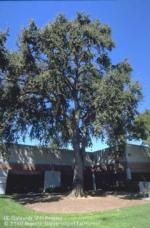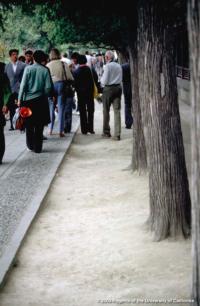Right tree, right place

A useful site for selecting a tree by attribute is Cal Poly's SelecTree. Or use the tree lists under the publications section of the main Trees page.
CLIMATE
San Joaquin County is in USDA Hardiness Zone 9 and Sunset Climate Zone 14. There are many trees that can be planted here, but not all of them should be planted. Because our summers are hot and dry, trees that can tolerate infrequent summer watering after establishment should be favored, unless they are planted in lawn areas.
Soils in the County vary widely; you can assess your basic soil type by using the online NRCS Web Soil Survey. It may also be useful to take a soil sample to a lab that can analyze the texture, nutrient content, and pH. Knowing the history of the site can be helpful in determining if there are compaction layers or chemical waste residues that will affect tree health. Tree species have different tolerances for acidity/alkalinity, nutrient deficiencies, and heavy soil with poor drainage. In the case of a very shallow, deep hardpan layer, a mound may have to be built up to provide adequate drainage and root zone capacity. Make the most of your investment by selecting a tree that tolerates your site: it is easier than completely altering your site to fit the tree you selected!
ROOT ZONE VOLUME
Trees planted in tree pits, wells, or strips often suffer from the lack of suitable soil adjacent to the planting space. The heavily compacted roadbase under pavement prohibits the development of a root system adequate to support a mature, healthy canopy, and structurally large enough to balance it. One solution is to use structural soils, which provide both sufficient support for roadways and adequate porosity for roots. CLICK HERE to read more.
Roots can also suffer when the soil around them is compacted by foot traffic, reducing the infiltration of water and air. A protective layer of mulch can significantly reduce the affects of foot traffic on the root zone.
